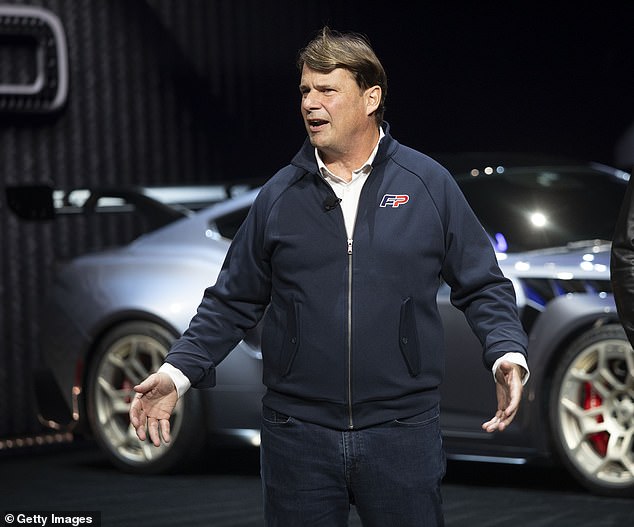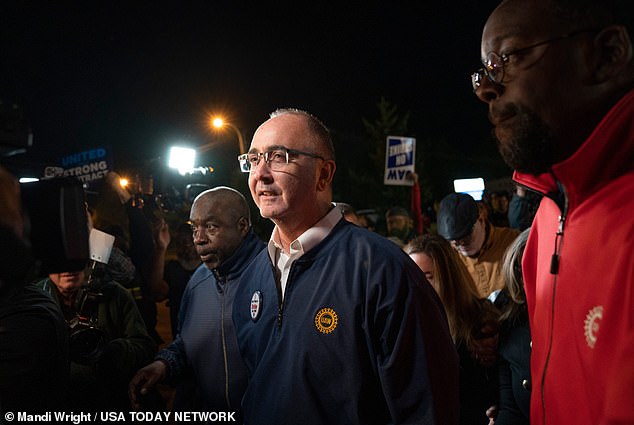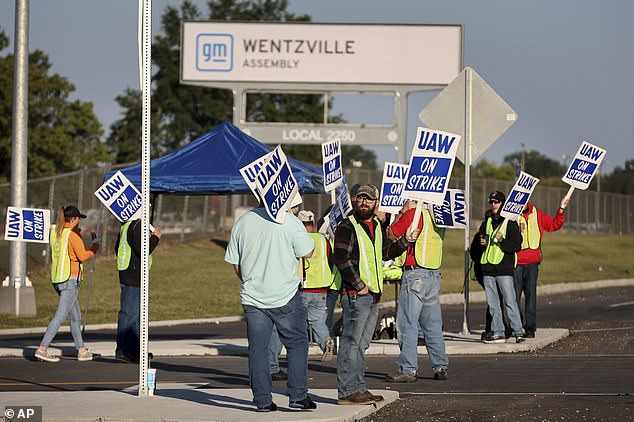Ford attempts to settle UAW strike by RAISING wages that will put workers among top 25% of all US hourly salaried jobs
Ford has made another attempt to settle the United Auto Workers (UAW) strike by raising wages to place workers in the top 25 percent of all U.S. hourly workers.
The company said they “made a comprehensive offer to the UAW in an effort to reach a tentative agreement” Tuesday evening after a 19-day strike.
The new framework agreement would last through April 30, 2028 – and is Ford’s “seventh and strongest offer on the key economic issues.”
Ford’s offer includes “unprecedented” wage improvements, which it says would put workers in the top 25 percent of all U.S. jobs, both hourly and salaried.
Ford has made another attempt to settle the United Auto Workers (UAW) strike by raising wages to place workers in the top 25 percent of all hourly U.S. jobs.

Jim Farley, president and CEO of Ford Motor Company, has been trying to make a deal
Jim Farley, president and CEO of Ford Motor Company, said Tuesday, “There is no doubt that our UAW workforce lifted our spirits during the pandemic, and those same workers and their families were hit hard by inflation.
“We want to ensure that our employees come out of these negotiations with two things: a record deal and a strong future.
“We have put an offer on the table that will be costly to the company, especially given our large U.S. footprint and UAW workforce, but an offer that we believe still allows Ford to invest in the future.”
This comes after major global automakers on Tuesday reported a rise in US new car sales for the third quarter, buoyed by resilient demand for the latest models and improved supply.
General Motors has had a strong year with U.S. sales up about 21 percent to 674,336 vehicles, benefiting from demand for its pickup trucks, affordable crossover SUVs and electric vehicles.
Electric vehicle sales rose 28 percent in the third quarter from the previous quarter, the company said.
Overall, new vehicle sales in the U.S. reached 1.33 million units in September, with an annual sales rate of 15.67 million units, according to data released Tuesday by Wards Intelligence.

UAW President Shawn Fain (center) organized the historic strike in an effort to keep companies in the dark about what might happen next and encourage deal-making
The robust performance comes against the backdrop of the United Auto Workers union’s ongoing coordinated strike against the Detroit Three automakers, which has raised concerns about supply disruptions in the current quarter.
September sales also benefited from inventory built up in anticipation of the strike.
GM said Tuesday it had 442,586 vehicles in inventory. While the impact of the strike was not addressed, a 40-day UAW strike in 2019 led to a 6 percent drop in sales in the fourth quarter of that year and cost the automaker $3.6 billion.
Rival Ford Motor is expected to report US auto sales on Wednesday, while Stellantis’ FCA US reported a 1.3 percent decline for the third quarter to 380,563 units.
Just last week, the United Auto Workers strike was expected to expand to more than 25,000 workers, as the massive strike against Detroit’s “Big Three” automakers entered its third week.
Striking workers added a Ford plant in Chicago and a General Motors plant in Michigan to the action, while further strikes were already underway that also affected Chrysler manufacturer Stellantis.
UAW President Shawn Fain announced the escalation of the strikes two days after former President Donald Trump chose to speak to protesters rather than attend the second Republican presidential debate.

General Motors workers picket outside the Wentzville, Missouri plant as the UAW union strikes for the first time in history against Detroit’s three major automakers
President Biden made history as the first sitting president to join a picket line the day before — albeit only for 12 minutes — as the more than 18,000 factory workers already on strike gained momentum in their demands for higher wages.
Fain called on 7,000 workers to join the fight, citing Biden’s historic visit while emphasizing that “America has our backs.”
Workers have been on strike at three factories: a Stellantis Jeep plant in Toledo, Ohio; a Ford plant in Detroit that produces Bronco SUVs and Rangers; and a GM plant in Missouri. The crippling factory shutdowns were also amplified by picket lines at 38 parts distribution centers in 20 states.
In August, as strike action was threatened but increasingly a reality, estimates from the Anderson Economic Group put the cost of even a 10-day union strike at a loss of $5.6 billion to the economy.
The strike began on September 15, when workers at one General Motors, Ford and Stellantis plant went on strike. The UAW has not attacked Ford’s distribution facilities, citing progress in negotiations.
Before Fain announced that the picket line was growing, focusing on “corporate greed,” talks between the parties had been promising.
He said they were working “day and night” on a new contract, but despite a “willingness to negotiate” there was “no meaningful” movement, causing the strike to spread to two more factories.
Fain blasted the automakers’ negotiators for hoarding record profits, saying the companies were “doing incredibly well, so we deserve to do incredibly well too.”
Negotiations over pay increases have been at a standstill for weeks, with the union pushing for wages that could be up to 40 percent higher over four years, along with cost-of-living adjustments and additional paid leave.
The car manufacturers made a counter offer of about a 20 percent increase with additional benefits. While they insist such a deal is historic, striking bosses argue it is well below what they can afford given near-record profits in recent years.
